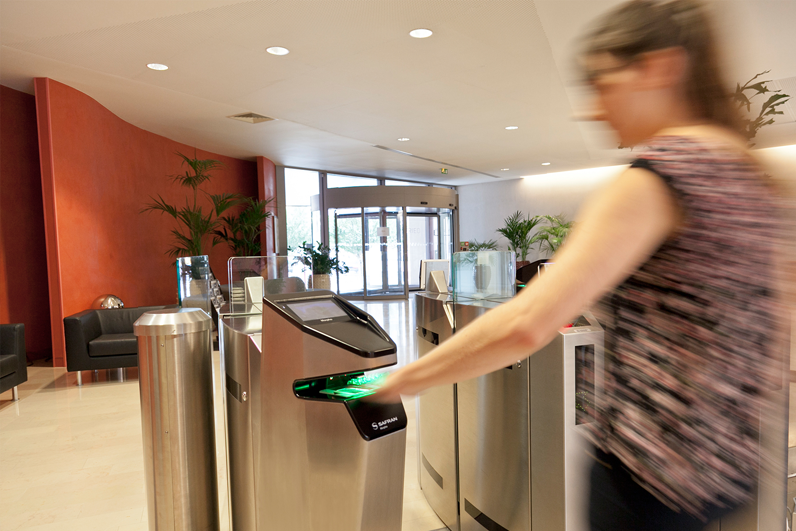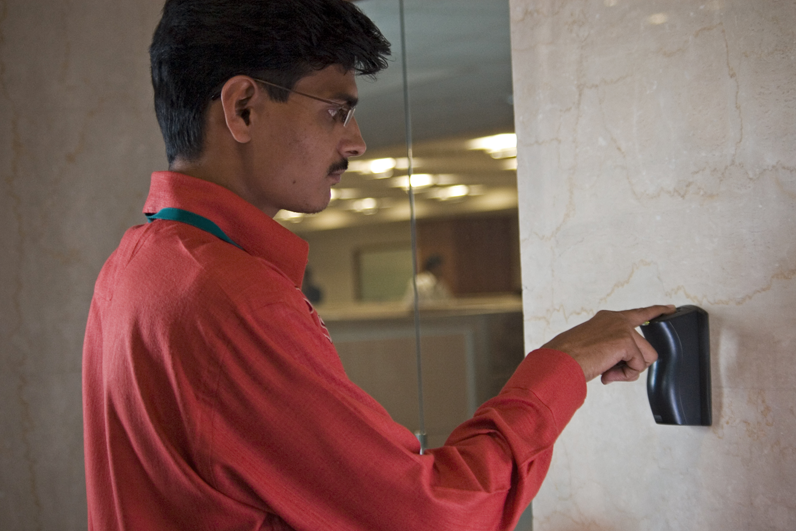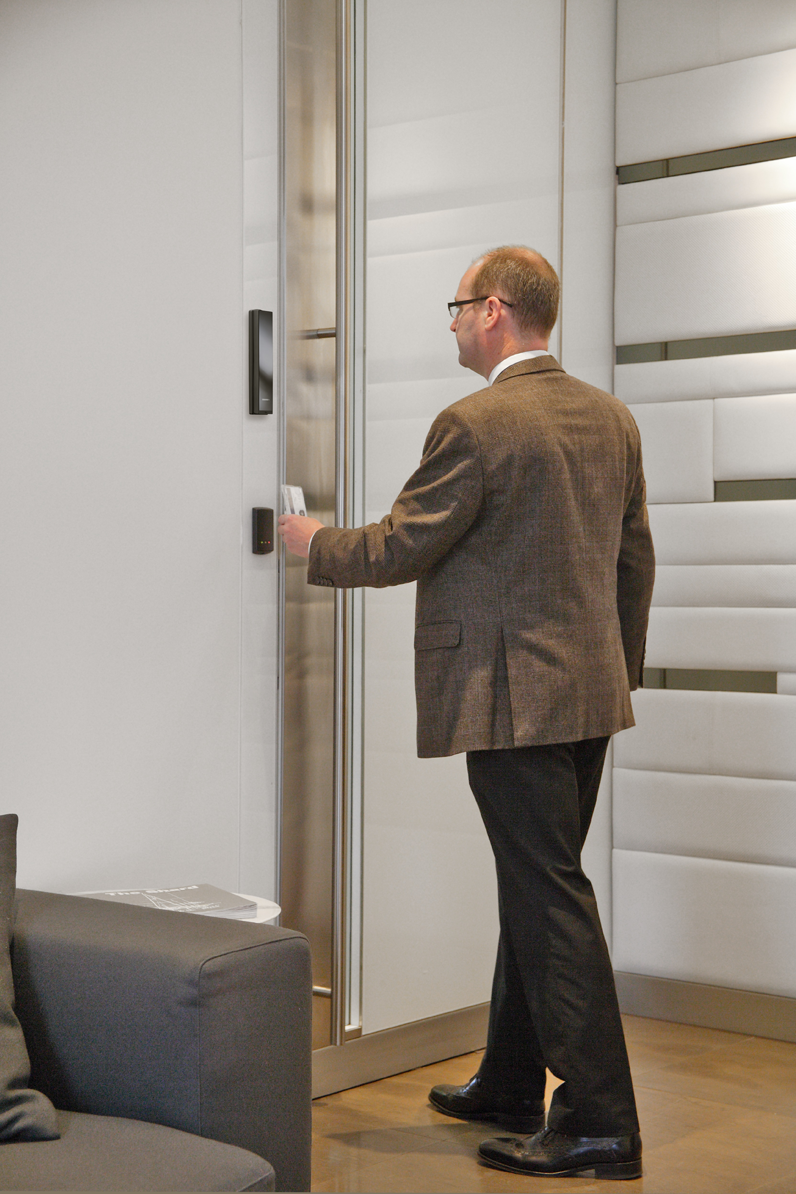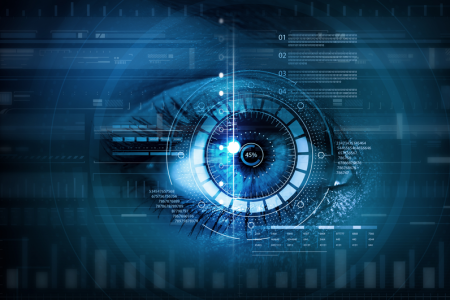Facial recognition to fingerprint: mapping out biometric security
Tim Compston, Features Editor at Security News Desk, investigates the changing nature of biometrics for access control.
The world of biometrics has come a long way since the early days of fingerprint readers. In the ensuing decades there have been major changes in the approaches available, whether it be fingerprint, vein, iris, face or hand geometry, their accuracy and, crucially, the cost of deployment. Of course as the level of risk increases so the desire to adopt some form of biometrics increases too so that ‘who you are’, the biometric signature, may be rolled out either by itself or alongside a card – ‘what you have’, and a PIN – ‘what you know’. While a typical office block may, in many cases, operate perfectly well with a card access system when something like a data storage room comes into the picture, which requires a more restricted level of access, in the opinion of key vendors it really makes sense to supplement a card with a biometric signature.
Of course as the economics of biometrics improves its footprint is sure to expand well beyond just high security and critical infrastructure applications. The fact that we are now seeing biometrics implemented in the consumer market on smartphones, for example, illustrates just how far the technology has found its way into our everyday lives. To put this into context, MarketsandMarkets forecasts that the global facial recognition market alone will grow from $2.77 Billion in 2015 to $6.19 Billion by 2020. Given this, biometrics, in all of its guises, is going to become an integral part of the vast majority of access control solutions in the not too distant future.
The changing face of biometrics

Offering a market analyst’s perspective, on the dynamics playing out here, Alexander Derricott, from IHS, says that this year [2016] is likely to mark a big turning point in the biometrics stakes: “At the moment biometrics for access control is dominated by fingerprint – a well-known format – and this isn’t going away anytime soon, however both facial and iris recognition are starting to gain much more momentum.”
Focusing on iris, in particular, Derricott (pictured left) reckons that it is finally living up to end users’ expectations. The big attraction with iris, which Derricott reiterates, is the high degree of accuracy that is delivered on the ground. Added to this there are a number of other factors which, he feels, are coalescing to make iris a much more attractive proposition: “The price is starting to come down and the units are sleeker and less vulnerable to environmental factors,” says Derricott. In terms of the sort of deployments which are coming on stream, Derricott tells me that iris is gaining ground for security critical areas like datacentre entrances: “It [iris] isn’t for somewhere that you might get eight thousand people walking through each day but, rather, for those key points, in a building, which need an extra bit of security.”
Turning to the position of facial recognition, Derricott says that this too is picking up more traction in the marketplace, although the big change is likely to come towards the end of the decade: “Some [facial recognition] products have tackled, successfully, the issues around ambient light – by using a different light spectrum – and have become more adaptive. It is no longer the case that if you decide to grow a beard one day and shave it off the next the system will, necessarily, reject you. There is also the mass throughput niche that they [facial recognition solutions] seem to be able to handle, such as the main door to an office. It is a lot more useable for day-to-day life.”
Asking Derricott if the added dimension which comes with a 3D version of facial recognition is catching on now, he replies that at the moment, from his analysis of the market this does not seem to be the case. In terms of other approaches to biometrics, finger vein – a very accurate form of biometrics – continues, reports Derricott, to have a relatively small base: “It is predicted to grow from $0.6 million in 2015 up to $2.2 million in 2020 so it is starting to gain popularity but from small beginnings” he says.
Addressing the debate over privacy and security, where the subject of biometrics is often raised, Derricott points out that in the context of EMEA, the Middle East and Africa are already happy to use biometrics: “There is less concern around biometrics with regards to privacy or security there.” He says that even in Europe biometrics is becoming much more acceptable to end users – and the general population – as it expands into other areas of life like smartphones, for example: “That is having a positive impact on governments and society which means that heavy restrictions in places like France, for example, are slowly dissipating,” explains Derricott.
Frictionless biometrics
Looking ahead, Derricott feels that frictionless biometrics technology is on track to have the upper hand over traditional fingerprint readers in the longer-term: “Fingerprint can have issues if you have grease or oil or you are dehydrated – and there are health/hygiene concerns – so using the face, iris or where you wave your hand, may be the way forward.” In terms of EMEA figures for biometrics, in the context of access control, Derricott says that IHS expects the overall market to expand by an impressive 8.6 percent (CAGR) over the forecast period of 2016 to 2020: “To give a bit of nuance on that, facial recognition will, potentially, be growing faster in the end years – so from 2018 to 2020 – than iris recognition and then reverse is expected to be true between 2016 and 2018, with iris growing faster than facial recognition,” he concludes.
The right balance
 Rafael Schrijvers, Product Marketing Manager for Access Control, EMEA, Tyco Security Products agrees that biometrics has always been an interesting topic in access control: “It gives a higher level of security after identifying what we have – like a card – what we know, a PIN code, a biometric can be a very convenient way of identifying yourself.”
Rafael Schrijvers, Product Marketing Manager for Access Control, EMEA, Tyco Security Products agrees that biometrics has always been an interesting topic in access control: “It gives a higher level of security after identifying what we have – like a card – what we know, a PIN code, a biometric can be a very convenient way of identifying yourself.”
Schrijvers (pictured right) adds that, ultimately, it is about weighing up what is convenient and what is secure and how we find the best way between the two: “Some of the hardware or biometric equipment that we see is very good but is it also convenient? If we speak about facial recognition and iris. In the beginning iris was not so convenient because you had to really look very closely into the camera but with the next generation of iris camera, the distance between reading and the eyes is farther away, so it is not so inconvenient anymore.”
He notes that fingerprint is still the most used aspect of biometrics for access control but he agrees that the market is moving more and more towards frictionless access control: “Ultimately what we want to have is not touching anything but to just walk through the door or the door is closed when somebody is not authorised.”
Customer requirements
 Seeking out the thoughts of Philippe Huysman, Global Portfolio Manager – Access Control, Siemens Building Technologies on biometrics, and the advantages – and issues – that come with its deployment, he takes the view that it is important to actually differentiate between the two distinct customer requirements for biometrics, namely: security and convenience. For security, Huysman (pictured left) explains that where customers with high-security requirements are demanding biometrics to ensure the verification of the identity of individuals, in this instance, it is mostly deployed as a second authentication factor in addition to a smart card. When it comes to convenience then Huysman reports that end users are wanting to adopt biometrics for increased efficiency: “These customers are looking to remove the need for any kind of physical card or key fob and therefore eliminate the associated lifecycle costs such as card issue and lost or defective card replacement. Furthermore, some organisations will select biometrics to reflect their brand values as it is perceived as more innovative or technologically advanced.” He believes that biometric technology has improved significantly in accuracy and reliability and that it has, generally, become more accessible and affordable. He is also keen to stress that when planning the use of biometrics it is vital to select a reliable partner with expertise and experience in deploying biometrics projects: “Guidance and training during the initial enrolment phase is fundamental for system performance. Sufficient time and discipline is required for this phase of the project.”
Seeking out the thoughts of Philippe Huysman, Global Portfolio Manager – Access Control, Siemens Building Technologies on biometrics, and the advantages – and issues – that come with its deployment, he takes the view that it is important to actually differentiate between the two distinct customer requirements for biometrics, namely: security and convenience. For security, Huysman (pictured left) explains that where customers with high-security requirements are demanding biometrics to ensure the verification of the identity of individuals, in this instance, it is mostly deployed as a second authentication factor in addition to a smart card. When it comes to convenience then Huysman reports that end users are wanting to adopt biometrics for increased efficiency: “These customers are looking to remove the need for any kind of physical card or key fob and therefore eliminate the associated lifecycle costs such as card issue and lost or defective card replacement. Furthermore, some organisations will select biometrics to reflect their brand values as it is perceived as more innovative or technologically advanced.” He believes that biometric technology has improved significantly in accuracy and reliability and that it has, generally, become more accessible and affordable. He is also keen to stress that when planning the use of biometrics it is vital to select a reliable partner with expertise and experience in deploying biometrics projects: “Guidance and training during the initial enrolment phase is fundamental for system performance. Sufficient time and discipline is required for this phase of the project.”
Limiting factors
On the subject of potential obstacles, Huysman points to privacy concerns and user acceptance as limiting factors in the growth opportunity for biometrics: “These concerns are understandable as identity theft is a growing problem. If a card is stolen, the card can be invalidated and a replacement issued, however if a fingerprint template is cloned and misused, the repercussions are much greater,” he explained.
Given such an issue, Huysman stresses that it is critically important to select the right biometric methodology: “Some biometrics are more difficult to collect and therefore less subject to exploitation, for example palm vein biometrics. Conversely, easily collectable biometrics such as facial recognition can have a high user acceptance as our faces are already in the public eye.”
Adding dimensions
Taking a closer look at some of the innovations now being brought to market, one vendor who is pointing to the future of biometrics is Swiss Manufacturer TBS (Touchless Biometric Systems). This is in the shape of 3D touchless finger scanning technology which, the company claims, is more accurate and hygienic than a traditional fingerprint reader and is proving popular in areas like datacentres.
With multiple sensors for 3D – rather than 2D – the TBS solution is designed to capture the highest possible quantity of fingerprint detail rather than, with 2D, simply a small central fingerprint. In fact, according to Philippe Niederhauser, Head of Sales and Marketing at TBS, 3D gathers about five times more information than 2D. He goes on to explain that, in practice, this greater detail means that the reader is in a much better position to cope when people have ‘bad’ fingerprints or have dust on their fingers.
Niederhauser (pictured right) is enthusiastic about the operational gains which can be realised with the extra dimension TBS offers: “The 3D finger scanner is still quite a unique product for the market.” He adds that the arguments which are winning through with customers go beyond simply accuracy. Other standout parts of the proposition here, says Niederhauser, concern hygiene – as the reader is touchless; the way that the solution can handle large databases, and, crucially, the favourable cost of ownership: “If you compare our 3D to a finger scan or fingerprint solution – where you can identify 1,000 people – we can go ten times higher than that but our cost isn’t ten times more.”
Returning to why a 3D finger scanning approach works so well for datacentres, Niederhauser suggests that having a webserver integrated into the TBS reader means that it can easily be adapted when workflows or regulations at the datacentres change.
Wonder wave
Remaining on the theme of a touchless or contactless approach to biometrics, the award-winning, high-speed, MorphoWave Towers stands out.

This, Morpho reveals, is able to capture and match four fingerprints simultaneously as the user simply waves their hand over the sensor to be identified so they can remain ‘on the move’ when passing through the control points. This Morpho solution also ties-in with the appetite in the access control market, which has been highlighted by a number of vendors and researchers, for frictionless access control at high traffic, sensitive, and secure locations.
Speaking about the MorphoWave Tower, Matthew Insley, Morpho’s Regional Director of Sales for Biometric Terminals says: “Right from the product launch, we had the firm conviction that our new product would be a major innovation for the access control sector.”
Finger vein
Focusing on veins in fingers or palms is an aspect of biometrics which has been around for a while now. For finger vein, specifically, Hitachi is the company which is very much the pioneer here. Originally coming out of medical research conducted in the 1990s this works by shining an infrared light into the finger that reacts with the haemoglobin in the blood. Scoring highly on accuracy – on a par with iris – and usability this technology has been employed in 80 percent of ATMs in Japan and also in a similar way in Poland and Turkey. More recently, also in the financial sector, Hitachi has been working with Barclays Bank to provide the bank’s customers with a finger vein reader so they can log in through a portal and digitally sign transactions. With regards to palm vein biometrics it is another Japanese vendor, Fujitsu, which is making the running with its PalmSecure sensors.

The face of the future
Another company seeking to redefine the world of access control in the security arena is UK-based facial recognition pioneer Aurora. Although Aurora may not be such a familiar name to security professionals it has a long and proven track record in delivering state-of-the-art biometrics solutions having cut its teeth in applications to match travellers to boarding cards at major airports, including London Heathrow’s Terminals 2 and 5 where over 15 million facial recognition events were processed in 2014, for example.

It was this time last year that Aurora announced the launch of the aptly-named FaceSentinel which is positioned as the world’s first biometric access control authentication product powered by what is referred to as ‘Deep Learning’. Designed for integration with existing access control systems, the beauty of this game-changing facial recognition system, according to the developers at Aurora is the way it brings together a powerful mix of AI (Artificial Intelligence) and infrared light – to overcome the challenges posed by fluctuations in natural light – to offer unparalleled facial recognition speed, accuracy, and reliability.
Fast forward to today and the next major move, just unveiled at IFSEC 2016 for FaceSentinel facial recognition is its integration with Fastlane gates and Door Detective anti-tailgating products from IDL. Aurora Head of Sales and Marketing Gary James puts the ‘world first’ this represents into context: “The big development that has taken place over the past year for us has been about using ‘Deep Learning’ to develop the engine so we can move from a one-to-one verification tool into a one-to-many identification tool. This means users don’t need any kind of token or card or whatever it might be to identify themselves.”
James (pictured left) adds that, with no additional tokens, swipe cards or badges, required to open a door or turnstile, the advantages in terms of user experience are huge: “Normally ‘contact’-type biometrics such as fingerprint scanning start to introduce delays into the throughput, but here we are demonstrating the exact opposite, with users able to glide through the gates.”

Building in biometrics
Keeping to the facial recognition theme, Tyco Security Products has just introduced facial biometrics for the immediate detection, and verification, of individuals as part of its VideoEdge video surveillance systems.
Stuart Bettle, Video Product Marketing Manager, EMEA, at Tyco Security Products, takes-up the story: “We already have some types of analytics built-in to VideoEdge but the Face Detection analytics adds more value for our customers by improving loss prevention and reducing investigation time.” Bettle explains the key elements of the solution: “I have a database within the VideoEdge so I can load in the faces of people that I wish to be on the lookout for. That could be for a good reason – such as VIPs in my shop – or it could be for a bad reason, people who have been banned. If I have strategically placed cameras near my entrances then, should a face be detected, the system will raise an alarm. I can also search for faces.”
Bettle is keen to underline the fact that the built-in facial biometrics in conjunction with VideoEdge works equally well from a proactive and – post-event – reactive perspective. He ends by cautioning that that, like any form of analytics technology, the positioning of cameras is absolutely vital here.
On the move
So to conclude, as we have seen biometrics in the context of security is an extremely dynamic and fast changing area. It will certainly be interesting, moving forward to see how new approaches, like voice biometric security which HSBC is rolling out for its banking customers in the UK, fit into the wider biometrics landscape where, the experts agree, contactless solutions are starting to make their mark.
[su_button url=”https://www.securitynewsdesk.com/newspaper/” target=”blank” style=”flat” background=”#df2027″ cr toolor=”#ffffff” size=”10″ radius=”0″ icon=”icon: arrow-circle-right”]For more information on the Security News Desk Newspaper click here [/su_button]











